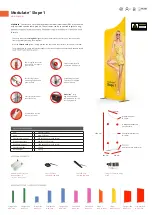
MULTICHANNEL SIGNAL CONDITIONER MODEL 482C GENERAL OPERATION MANUAL
2
CAUTION 2: ESD considerations should be made prior to performing any internal adjustments on the equipment.
Any piece of electronic equipment is vulnerable to ESD when opened for adjustments. Internal adjustments should
therefore be done ONLY at an ESD-safe work area. Many products have ESD protection, but the level of protection may
be exceeded by extremely high voltage that is typically present in normal situations.
1-3.
Equipment Rating
For complete specifications, please refer to the enclosed Specification Sheet. This equipment operates optimally at +32
to +120°F (0 to +50°C), in an environment having <85% relative humidity. Its line power frequency range is 47-63 Hz.
The 482C15/482C05 devices require 34-38 VDC with 200 mA to operate. In turn, they supply 26 VDC @ 2 to 20 mA
excitation voltage to connected ICP
sensors or in-line charge converters. The units get power via AC power adaptor
PCB Model 488A04, 36VDC battery pack, or a car adapter which all plug into a receptacle on the rear panel (PCB
Model 488A11).
1-4.
Model 482C15 System Description
The Model 482C15 is a four channel signal conditioning unit designed to interface measurement signals to readout or
recording devices.
The following are features that come standard on 482C15 units:
Input fault and overload LED’s with jumper selectable overload level of +/-5V or +/-10V
Variable ICP
®
source current, 0 to 20 mA
Jumper selectable Voltage input mode
Jumper selectable gain of x1, x10, x100 (482C15 Only)
Lighted power indicator on the front panel
Rear panel BNC input/output connectors
Optional L.P. plug in filters (477A series type) various 2-pole frequencies avail. Consult factory
1-4.1.
Model 482C15 ICP
®
Input/Output Mode
The Model 482C15 contains a regulated 26 VDC power supply that provides constant current for up to 4 individual
channels. Both the output and input connections utilize BNC connectors and are brought out through the rear panel. The
unit is AC coupled only. The 482C series offers optional DC Coupling. Consult factory
1-4.2.
Adjusting the Current Source
The Current adjustment is located on the rear of the unit. Use a standard small flat screwdriver to adjust the “I ADJ”
potentiometer. Turning the adjustment slot clockwise will increase the current, while counterclockwise will decrease the
current. Do this adjustment only while a DC mA meter or DMM set to mA is connected to any “ICP” BNC. One
adjustment controls all channels. The unit is factory set to 4mA and can be adjusted between 0mA-20mA.
1-4.3.
Fault Indications
The three red LED’s on the front panel are all indicators of some type of problem. The normal good operation state is
when all fault lights are off. The “OPEN” light indicates that the Bias voltage is over that of most sensors and is close to
an open circuit voltage of 26VDC. The photo on the cover is shown with the unit on, and no sensors attached, so the
“OPEN” LED is on. The “SHORT” light indicates a very low Bias voltage close to 0VDC. The “OVERLOAD” light
































